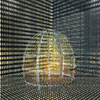Ever want to hear Meat Loaf sing a duet with Clapton? Well, you can, after I show you how to record two songs at once onto the same tape. It's really simple, and can provide hours of fun. I know you may be skeptical, but believe me, this is an unparalleled sonic experience.
WHAT YOU WILL NEED
- One multimedia computer (PC) with a CD player, headphone jack, and microphone jack
- One tape, CD, or minidisk player with a headphone jack, preferably stereo (AP-A)
- One tape or minidisk player with a microphone jack, preferably stereo (AP-B)
- A CD and a tape, CD, or minidisk (whatever AP-A plays). Both of these need to have one of the songs you want to combine.
- One blank tape or minidisk
- Two audio extention cords with the "male" connector on both ends (this is the kind of plug that goes into headphone and microphone jacks)
SETTING UP (HARDWARE)
OK, now that you've got all that funky stuff, it's time to begin. First, connect your equipement, as follows (see fig. 1).
NOTE: These setup instructions were written assuming you do not want to clutter your hard drive with large sound files. If you have enough hard drive space, a fast high capacity disk drive, or a good and fast MPEG converter, you can cut AP-A out by just recording the first CD track as a WAV or MPG file. Or you can cut AP-B out if you desire to save this file to disk. However, most will find it easier to just use the PC as a mixer and not bother with saving these large sound files to disk.
- Find the microphone jack on your computer. It should be in the same basic area as your peripheral and monitor jacks. This can be on the side or back of your computer. Connect a cable to this jack, then connect the other end to the headphone jack of AP-A
- Connect the other cable to the headphone jack of your PC. Connect the other end to the microphone jack of AP-B
- Open your PC's audio mixer program. Make sure the play settings for CD and Line In (in this case, AP-A) are not muted.
- Put your CD into your computer's CD drive
- Put your CD or tape or minidisk into AP-A
- Test your setup by playing from your PC and from AP-A. Both of these should come out of AP-B's speakers.
- Make sure both the PC and AP-A
- Set both PC and AP-A to the desired track locations
- Press "rec" on AP-B and "play" on AP-A and PC. This will record the track from AP-A and PC simultaneously on AP-B

Fig. 1: Connecting your equipment
PLANNING YOUR OVERDUB MIX
The hardware setup is the easy part. Planning your overdubs is very tricky, but it is worth it.
There are five rules to good overdubbing
- Match the song running times: I use the 7 second rule, which states that no two spliced tracks should have more than a 7 second difference. If the longer song has a long instrumental intro or conclusion, then you can have the shorter song come in or end during that instrumental. Always start the shorter song a few secodns after teh first, so the time difference is divided between the beginning and end, and thus not as noticable.
If your liner notes or CD package do not show the track times, you may be able to get them from the status display of one of your CD player programs on your PC.
- Use those longer songs by overdubbing them with with two or more shorter songs: GOt a ten minute song you want to use, but can't find a song long enough to match it to? Just overdub it with two five minute songs. Of course, it is best to pick two songs from the same group to use here, so the effect is less jarring when the first song ends and the second one begins.
- Match the volume levels: If one song completely obliterates a softer song, then why overdub it? Most overdubs are best served by having both songs at the same approx. volume, but sometimes having a somewhat softer song mixed with a louder one can produce a pleasant "background sampling" effect.
- Try to match songs that are from different genres: Some of my best overdubs are freaky combinations like Metallica and Ace of Base or Bryan Adams and Danzig.
- Be very careful about overdubbing an artist or group with itself: Sometimes, if you splice two songs by the same person/group, the sounds of the two tracks will interfere with each other. For example, when I overdubbed two Meat Loaf songs, the Loaf's voice from the first track would cancel the Loaf's voice fromt eh second track, producing short bursts of static.
Aside from those rules, specific to overdubbing, you should try to get as close as possible to actually filling your tape without cutting the last song off. Also, it is usually best to put your favorite songs toward the end.
Another thing you may want to consider is putting a reverb track in there somewhere. That's where you overdub a song with itself with a slight difference in start times. If you do this, you should use a time difference of 1/2 second to 2 seconds, depending on how pronounced you want the effect to be. If one of your sources is a tape (very likely as you may not have two CDs with the same song on them), you should start the tape first, because tapes stretch, so the tape's track will most likely be slightly longer and this will help adjust for that length.


